Knitted slippers, knitted using a variety of patterns (including two knitting needles), are a great alternative to house shoes for children and adults, as well as a touching, heartfelt, warm gift for loved ones, made with your own hands.
Even the most inexperienced craftswomen, familiar only with the basics of knitting, can make this useful element of a home wardrobe. All you need to do is choose a suitable model with a description of the work and strictly follow the recommendations.
Yarn for slippers
Knitted slippers must be not only beautiful and warm, but also comfortable to wear, otherwise they will not be able to fully please their owner.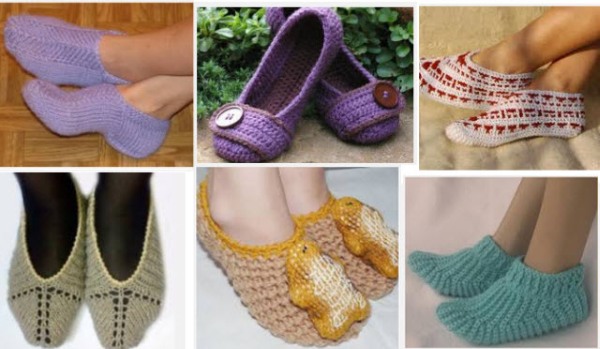
The comfort of a knitted product largely depends on the yarn, so when choosing it, you need to take into account some important nuances:
- To ensure that the product is as warm as possible, it is important to pay attention to yarn composition. Experienced knitters recommend choosing natural wool and semi-wool threads for socks and slippers. Products made from them are very warm, breathable, and also the most durable.
- The second important parameter is yarn thickness. If you choose a thin thread, the slippers will not be warm, if the yarn is too thick, the product may not be very comfortable to wear. The best option is medium-thickness threads: 200-300 m / 100 g. You can also take thinner yarn, but in this case knit the product in 2-3 folds of thread.
- If the slippers are to be knitted for a child, it is worth giving preference to a special one. baby yarn, because it is hypoallergenic, has a safe composition and is very pleasant to the touch.
- Choice product colors always remains up to the craftswoman, but if the slippers are to be knitted from different yarn scraps, it is very important that they not only match in color, but also be of approximately the same thickness and texture. If this simple rule is not followed, the knitted fabric may turn out uneven and sloppy.
What kind of sole to choose (make) for slippers
The sole of the slippers can be made of various materials. The simplest and most common option is a sole knitted from the same or thicker yarn as the slippers.
For strength, many needlewomen add another thread to the main thread while knitting.
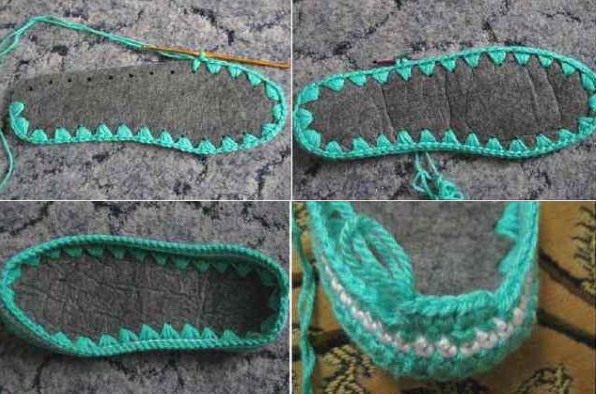 If a more wear-resistant option is required, the sole can be made of felt or thick leather. Its shape is easiest to cut out according to a suitable insole. The sole can be made separately and then knitted or sewn onto the finished product.
If a more wear-resistant option is required, the sole can be made of felt or thick leather. Its shape is easiest to cut out according to a suitable insole. The sole can be made separately and then knitted or sewn onto the finished product.
Knitting needles
To knit socks and slippers, craftswomen use special stocking needles, which are sold as a set of 5. They differ in the material they are made of (metal, wood, plastic) and diameter (marked with numbers).
The material from which the needles are made is not of fundamental importance; it is a matter of personal preference.
The number of knitting needles is selected depending on the nature of the product and the thickness of the selected threads. For knitting slippers and socks, it is recommended to use a knitting needle diameter that approximately matches the thickness of the thread. In this case, knitting will be as comfortable as possible, and the fabric will be dense, even and beautiful. For example, for yarn 250-300 m/100 g, knitting needles No. 2.5-3 are optimal.
Additional accessories for knitting slippers
In addition to yarn and knitting needles, when creating knitted shoes you may need:
- knitting markers (special plastic hooks used to mark stitches when calculating);
- hook (it is convenient to use to hide the “tails” of cut threads, as well as to tie the edges of finished products);
- a thick needle with a wide eye (for sewing items).
All of these knitting supplies can be purchased at craft stores along with yarn and knitting needles. Women's and children's slippers, knitted with your own hands, can be complemented with accessories that will make the item more interesting, beautiful and unique in its own way.
For this purpose, the following are used:
- decorative buttons;
- beads;
- crochet flowers;
- bows and ribbons;
- pompoms etc.
Commonly Accepted Abbreviations
Knitting (slippers on two needles): patterns, description of works, presented below, contain generally accepted abbreviations:
- Loops – p.;
- front loop - knit stitch;
- purl stitch - i. p.;
- edge loops - edge;
- row - r.
Simple slippers on two knitting needles
This simplest model of slippers is knitted on two knitting needles in just a couple of hours, the proposed scheme is an ideal option for beginner needlewomen: it will help to "get the hang of" the hand and will please with an original appearance. Calculations are given for foot size 38-39.
Necessary materials
Scroll:
- Yarn (300m/100g) – 1 skein.
- Needles No. 3.
- Knitting markers.
- Needle for stitching.
- Additional accessories.
Sequence of work
Execution:
- You need to cast on 63 stitches. The first row is made with a classic 1/1 elastic band.
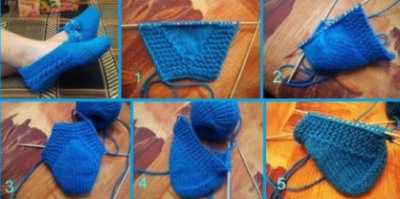
- The central loop (33rd) is marked with a knitting marker. Starting from the 2nd row (then in all purl rows) you should make increases: make a yarn over before the loop in the center and immediately after it, knit them from the front side as crossed. Continue knitting according to the pattern with a rib and make increases until the total number of loops reaches 85.
- On the left side of the product, remove 44 sts onto an additional knitting needle and set aside for now. Start forming the sole: on the right side, close 4 sts at the beginning of the row and knit 7 cm high with garter stitch.
- Proceed to assembly. Transfer the loops from the auxiliary knitting needle to the working one. Moving from the toe to the heel, sew the loops from both knitting needles with a needle (stitch "loop in loop"). Close the remaining 5 sts. Make a side seam. Sew the heel, connect the toe.
- If desired, the top of the product can be crocheted, and the finished socks can be decorated with additional accessories.
Slippers on two knitting needles from a rectangle
This original model of slippers resembles oriental footwear in appearance, and it is very easy to knit it on two knitting needles, because during work you will not even need to perform any increases or decreases according to the pattern. The basis is a rectangle knitted with garter stitch (all rows are performed only with face loops).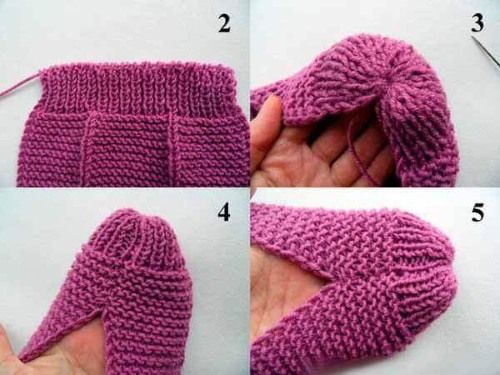
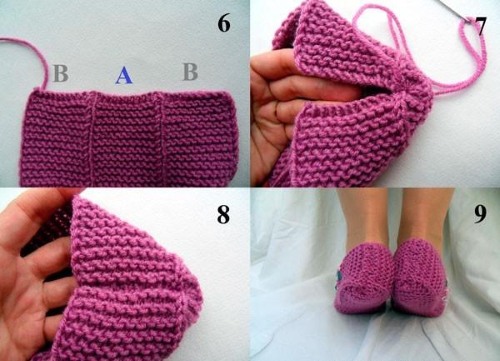
The most impressive look is achieved by making such socks from sectionally dyed yarn., but they can be knitted from both single-color threads and multi-colored leftovers.
To work you will need:
- Yarn (250 m/100g) – 1 skein.
- Needles No. 3.
- Needle.
- Hook.
Sequence of work
Execution:
- First of all, make calculations so as not to make a mistake with the size of the slippers. Measure the length of the foot, multiply by 2 - this is the required width of the rectangle. From the yarn you like, knit a trial sample of 10 sts, measure it and calculate the required number of loops for the resulting width.
- Based on the calculations obtained, loops are cast on the knitting needles, a garter stitch rectangle 12 cm high is made. The loops are closed, and the top is processed with a hook in any convenient way - columns, picots or "shells".
- Fold the rectangle in half, form the toe by folding the edges of the product into a cone shape. Sew along the sole line.
Men's knitted moccasin slippers
Men's slippers, reminiscent of moccasins, are knitted on two knitting needles according to the given pattern quite easily and quickly, but at the same time they look very original. The given calculations correspond to size 40-41. The entire product is made with a simple garter stitch, that is, in all rows the loops are always knitted only with the front loops.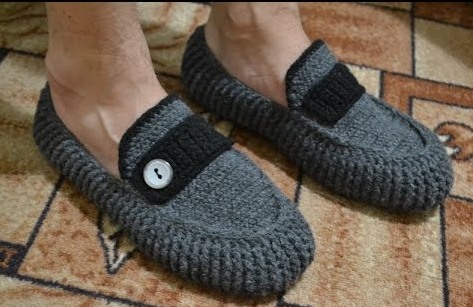
To make them you will need:
- Medium thickness yarn – 80 g.
- Needles No. 3.
- Hook for decorative processing.
Sequence of work
Execution:
- Cast on 48 stitches, the first 4 rows are done in garter stitch.
- 5-6 rows. Additions are made according to the following principle: edge, 1 l p, 1 yarn over, *4 l p, yarn over*, repeat from * to * to the end of the row. Taking into account the additions, there are 60 sts on the needles. From the wrong side, yarn overs should be knitted behind the back wall.
- 7-26 p. It is done in garter stitch.
- They begin to form the sole. Using knitting markers, mark the middle 10 sts. Knit the first 24 sts, knit the next two sts simultaneously, then the central 10 sts and one side st. Turn the work to the wrong side, knit the first two sts simultaneously, knit the next 8 sts, knit the outermost of the central sts and the first of the cast-on sts together again, turn the work to the right side. Continue decreasing in this manner until all the side sts are closed, and only the central sts should remain on the needles.
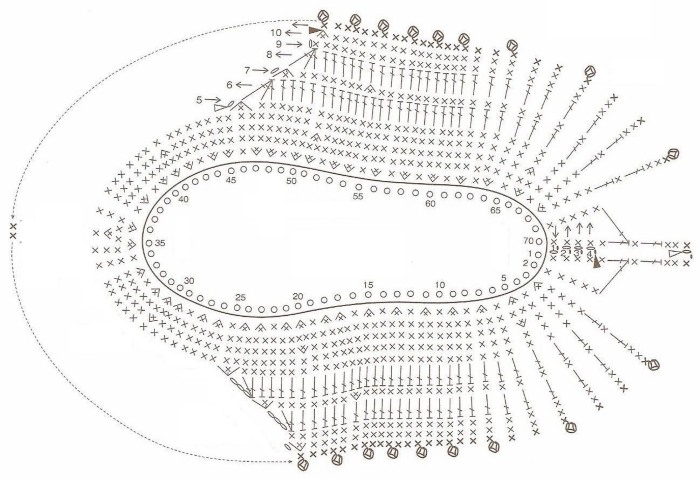
- The heel is knitted. From the edge loops, cast on 13 sts on both sides of the remaining loops, 36 sts on the needles. Perform 26 rows of garter stitch. Continue working with decreases in the front rows: knit two loops at the same time at the beginning and end of the row, as a result, only 10 central loops should remain on the needles.
- Form the toe: on the right and left sides of the loops remaining on the knitting needles, cast on 25 sts from the edge loops. Next, form the toe in the same way as the heel. Knit 10 central loops, knit the outer loop together with the first from the cast-on row, turn the work. Knit the central loops, the outer loop also - at the same time as the first from the side row. Continue working, only 10 sts should remain on the knitting needles again. They need to be closed.
- Crochet the outline of the toe (with single crochets), decorate as desired. The second slipper is knitted in the same way as the first.
Slippers-socks on two knitting needles without a seam
The most comfortable socks and slippers for adults and children are those knitted on two needles using a seamless pattern: they fit tightly to the foot, without causing any discomfort when worn. Seamless slippers are also advantageous because they can be worn not only at home, but also under shoes in cold weather..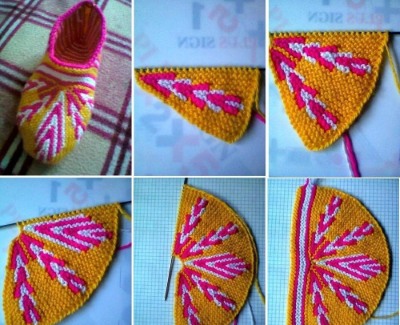
The master class presents calculations for foot size 36-38.
Prepare materials:
- Yarn (250 m/100 g) – 1 skein of the main color, 50 g of finishing yarn of a contrasting color;
- Needles No. 3.
Sequence of work
Execution:
- Using the main yarn, cast on 47 sts. Rows 1-6 are worked with a standard elastic band (edge, 1 i.p., 1 l.p.).
- Find and mark the center (24th st) with a knitting marker. Continue working with the finishing thread: edge, *1 i.p., 1 l.p., 1 i.p., transfer 1 st to the knitting needle (do not knit, the thread is behind the work) * - then repeat from * to * to the center. Before the marked loop, make a yarn over, remove the central one, make another yarn over, finish knitting the row in the same way as the first half. The back side should be knitted as shown in the pattern, the removed loops are also transferred (do not knit), the thread is left in front of the work. Before and after the central loop, yarn overs are also made, while the yarn overs from the previous front row are knitted with a crossed front loop.
- Switch to the main yarn again: edge, *1 i. p., 1 l. p. transfer (yarn behind work), 1 i. p., 1 l. p. * — repeat from * to * to the center. Knit the central loop as a front one, yarn overs are also made before and after it. Knit to the end of the row according to the same pattern. The purl row is performed in analogy with the previous one.
- According to the described principle, repeat the 14 subsequent rows, alternating the main and finishing threads.
- Proceed to knitting the sole: count the middle 15 sts, mark with markers. Knit with the main yarn in a rib pattern up to the central 15 sts. They are also knitted in a rib pattern, the outer loop and the first from the side row are knitted at the same time. The work is turned over. Knit 14 sts according to the pattern, the outer loop is knitted at the same time as the first from the side row, then the work needs to be turned over again. Continue knitting according to this principle, as a result, only 15 sts should remain on the needles.
- Heel. On both sides of the central 15 sts, 16 sts are cast on from the edge sts. The heel is formed using the same principle as the sole, i.e. you need to knit two sts at a time from each edge until only 15 sts remain on the needles again. Close the sts. Using a hook, hide the ends of the cut threads, decorate as desired.
Children's slippers on two needles
In winter and autumn, it is especially important to ensure that the feet of children are always warm - both at home and outside. Slippers-socks will perfectly cope with this task, and you can knit them according to the given pattern on two knitting needles in literally one evening. Calculations are given for slippers for a child up to one year old.
For knitting you will need:
- Children's wool or acrylic yarn - 60 g of the main color, 30 g of another color for decoration.
- Needles No. 3.
- Hook.
Sequence of work
Execution:
- Using the main yarn, cast on the initial row of 25 sts and perform 2 rows of garter stitch.
- Using finishing yarn, knit the next 2 rows in garter stitch.
- Return to the main yarn and do 2 more rows with the same pattern.
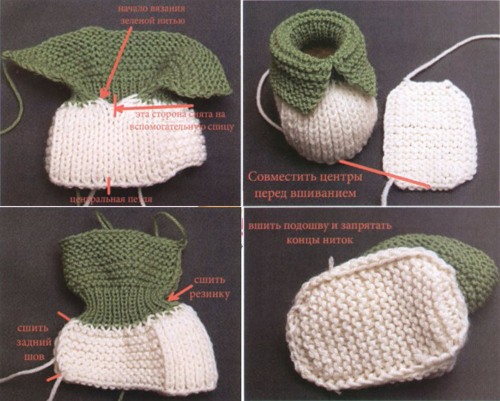
The knitting pattern for children's slippers on two knitting needles is shown in the photo. - 7-8 p. Mark the central loop with a marker, continue working with contrasting yarn according to the pattern: edge, *1 knit stitch, 1 transfer to the knitting needle (do not knit, yarn behind the work) *, repeat to the center. Pull 7 sts out of the marked loop. Finish the row also according to the pattern from * to *. From the wrong side, the loops that were thrown over are removed again, but the yarn should now remain in front of the work, the rest should be knitted as front loops (including 7 yarn overs from the central loop).
- Rows 9-10 should be knitted with garter stitch in the main color.
- Row 11 is knitted with finishing yarn: edge, *1 is transferred to the knitting needle (yarn behind the work), 1 knit stitch*, 7 loops are also knitted from the central stitch.
- Row 12 – knit according to the pattern, similar to row 8.
- Rows 13-14 – garter stitch with main yarn.
- Rows 15-16: knit according to pattern 7-8 rows.
- Rows 17-18: knit all stitches with the main yarn.
- Rows 19-20 – garter stitch in the main color.
- The rest of the work is continued only with the main color. Rows 21-25 are done with garter stitch.
- Row 26: 20 sts should be knitted, on the next three central loops start to close the sole: 2 sts are knitted, the third loop is knitted simultaneously with the first side purl. The product is turned over. The first loop is removed, one is knitted as a front loop, the third together with the first from the side row, the work is turned over again. Continue knitting like this until all the side loops are finished.
- Form the heel: cast on 13 sts from the edge loops on both sides of the central ones. Close them in the same way as the sole. Close the remaining central loops, hide the threads with a hook. The slippers are ready; if desired, decorate the product with additional accessories.
Any of the given patterns for knitting slippers on two knitting needles can be taken as the basis for your work, and the size can be varied depending on your needs, adding or decreasing the number of loops and rows.
The same can be said about the design of knitted slippers: color solutions, variations on the theme of patterns and decor have no limits. Knitting is a creative process that brings not only practical benefits, but also pleasure.
Video: knitting, slippers on two needles, patterns
How to knit slippers without seams, video tutorial:
Traces on two knitting needles, see the video:
https://www.youtube.com/watch?v=qOY0zNbnzEU

I really like super job